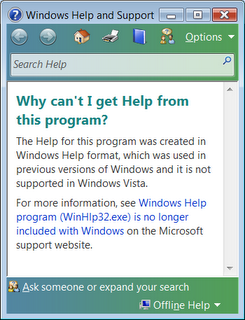
At some point you're likely to encounter a problem or a task that confusion. To understand, you need to know how to get the right help. This article provides an overview of the best techniques.
Using Windows Help and Support
Windows Help and Support by integrating the online help for Windows. It is a place to get quick answers to questions, suggestions and troubleshooting instructions on how to do things. Note, however, not help you with software that is not part of Windows so that you'll need to consult the program of aid (see "Getting help with software below ).
To open Windows Help and Support, click the Start button, then click Help and Support.
Search Help
The quickest way to help is to type a word or two in the search box. For example, to obtain information about wireless networking, type of wireless network, and then press ENTER. A list of results appears, with the most useful results at the top. Click on one of the results read the topic.
If you are connected to the Internet, your searches may include new help topics and the latest subjects of the Windows Help online. To learn how to get these updates, see Get the latest Help content.
Browse Help
You can browse help topics by subject. Click the Browse button, then click an item in the list of topics that appears. Topics may include help topics or elsewhere. Click on a Help topic to open it, or click another heading to dig deeper into the subject list.
Get help with software
Almost every program comes with its own in-aid system.
To open a software support system:
In the Help menu in the software, click the first item in the list, such as "Show Help", "Help", or a similar sentence. (This text may vary.)
- Or --
Press F1. This function key opens aid to almost any software.
Getting help with dialog boxes and windows
In addition to program-specific aid, some dialog boxes and windows contain links to help topics of their specific functions. If you see a question in a circle or square, color or text and underlined the link, click it to open back up.
Get help from other users of Windows
If you have a question that can not be answered by information assistance, you can try to help other Windows users.
Post a message in a newsgroup
Newsgroups are Internet discussion groups where people converse on a wide range of topics. Participation is free and people around the world to participate.
For help other users of Windows Vista, Windows Vista go to the website for discussion. Once there, research focus groups to see if someone else has already addressed the problem. If not, send a message in one of the groups. You are probably (but not guaranteed) to get a response from other users in a day or two.
You can also read and ask questions directly to newsgroups from Windows Mail, without using the Web. See Read messages forums and send a message to a newsgroup.
Note
You need a Windows Live ID (formerly called Microsoft. NET Passport) to ask a question to a discussion group on the Newsgroups Windows Vista Web site (Windows Mail does not have this requirement). If you do not have a Windows Live ID, you will be asked to create a first time you try to ask a question. You do not need a Windows Live ID to search or read newsgroups.
Invite someone to help via Remote Assistance
If you have a friend or family member who is an expert in computer, you can invite that person to connect from his computer to your computer via Remote Assistance. This person can see your computer screen and talk with you about what you see both. With your permission, your assistant can even control your computer remotely, enabling it to resolve the problem directly. See Windows Remote Assistance: frequently asked questions.
Use resources on the Web
The Web contains a large amount of information, then there are good chances that the answer to your question lies somewhere in the billions of Web pages. A general web search, then, is a good place to start your quest. For more information, see "Web Search" in the discovery of the Internet.
If you do not find what you need using a general search, consider looking for Web sites that focus on Windows or problems. Here are four good places to consider:
Windows Help online. This Web site provides an online version of all help topics in this version of Windows, as well as instructional videos, in-depth columns, and other useful information. (Go to the Windows Help online.)
Microsoft Help and Support. Find solutions to common problems, how-to topics, troubleshooting steps, and later downloads. (Go to the Microsoft Help and Support Web site.)
Microsoft Knowledge Base. Search a vast database of articles with detailed solutions to problems and bugs. (Go to the Microsoft Knowledge Base Web site.)
Microsoft TechNet. This site includes resources and technical content for professionals in information technology. (Go to the website of Microsoft TechNet.)
Get help from the pros
If all else fails, you can get help from a professional technical support someone whose job is to solve problems. You can contact a professional support via telephone, e-mail, or through an online chat.
Who, you should contact depends on how you obtained Windows. If you purchased a new computer and Windows has been installed on it, your computer manufacturer provides support. If you purchased separately from Windows, Microsoft provides support. Support may require a fee or for free, under the terms of your purchase and if you have submitted applications for previous grants.
Customer support for options that apply to your computer, including phone numbers, click the Apply button at the top of the Windows Help and Support window.
